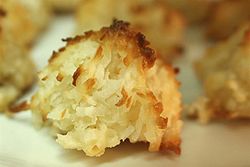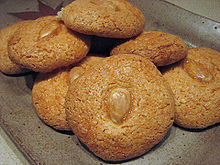- Macaroon
-
A macaroon (/mækəˈruːn/ mak-ə-roon) is a type of light, baked confection, described as either small cakes or meringue-like cookies depending on their consistency. The original macaroon was a "small sweet cake consisting largely of ground almonds"[1] similar to Italian or Moroccan amaretti.
The English word macaroon and French macaron come from the Italian maccarone or maccherone. This word is itself derived from ammaccare, meaning crush or beat,[2] used here in reference to the almond paste which is the principal ingredient.
Most recipes call for egg whites (usually whipped to stiff peaks), with ground or powdered seeds, generally almonds or nuts. Alternatively, coconuts, a seed, can be used. Almost all call for sugar. Macaroons are sometimes baked on edible rice paper placed on a baking tray.
Contents
Regional varieties
Scottish
The Scottish macaroon is a sweet confection with a thick velvety centre covered in chocolate and topped with roasted coconut.
Traditionally they were made with cold leftovers of mashed potatoes and sugar loaf. When the macaroon bar became commercial the recipe no longer used mashed potato because of shelf life limitations. The modern macaroon is made from a combination (depending on producer) of: Sugar, Glucose, Water and Egg White. These ingredients make a fondant centre.
This recipe was reportedly discovered by accident in 1931, when confectioner John Justice Lees was said to have botched the formula for making a chocolate fondant bar and threw coconut over it in disgust, producing the first macaroon bar.[3]
North American
In North America, the coconut macaroon is now the better known variety. Commercially made coconut macaroons are generally dense, moist and sweet, and often dipped in chocolate. Homemade macaroons and varieties produced by smaller bakeries are commonly light and fluffy.
Macaroons made with coconuts are often piped out with a star shaped tip, whereas macaroons made with nuts are more likely shaped individually due to the stiffness of the dough. Because of their lack of wheat and leavening ingredients, macaroons are often consumed during Passover in many Jewish homes.
Coconut macaroon
A coconut macaroon is a type of macaroon most commonly found in the United States, The Netherlands (Kokosmakronen) and Germany, and is directly related to the Scottish macaroon. Its principal ingredients consist of egg whites, sugar and shredded dried coconut. It is closer to a soft cookie than its meringue cousin, and is equally as sweet.
Many varieties of coconut macaroons are dipped in chocolate, typically milk chocolate. Versions dipped in dark chocolate or white chocolate are also becoming more commonly available. Nuts are often added to coconut macaroons, typically almond slivers, but occasionally pecans, cashews or other nuts.
In Australia, a blob of raspberry jam is often concealed in the centre of the macaroon prior to cooking.
French
In France, the coconut macaroon is known as the "congolais".[4][dubious ] Another name for the coconut macaroon is "le rocher à la noix de coco". The almond flour version is simply called "le macaron" in French. See main article at macaron.
Spanish
In Asturias, Spain, there is a macaroon variety made with hazelnuts and honey called "carajitos."
Indian
Tuticorin also known as Pearl City and Mangalore have their own varieties of macaroon made with cashews and egg whites.
Ireland
The Macaroon Chocolate Bar is made by Wilton Candy in Co. Kildare, Ireland. The description on the packaging is "Macaroon pieces in Irish milk chocolate", The ingredients contain milk chocolate, desiccated coconut and vanillin. It was first made in 1937.[5]
Turkish
Acıbadem kurabiyesi is a traditional Turkish cookie made of almonds, sugar and egg whites. The traditional recipes include a small amount of bitter almonds, which gives this cookie its name. Because bitter almonds are not readily available, almond extract is typically used as a substitute. These cookies are part of the stock-in trade of almost every bakery in Turkey, as they are seldom made at home.
Origins
The earliest recorded macaroon recipes are for the almond meringue variety similar to amaretti, with a crisp crust and a softer interior. They were made from egg whites and almond paste. Mrs Beeton's Book of Household Management[6] gives a recipe for a macaroon of this kind.
The name of the cookie comes from an Italian word meaning paste, maccarone. While origins are uncertain, some culinary historians claim that macaroons can be traced to an Italian monastery. The monks came to France in 1533, joined by the pastry chefs of Catherine de Medici, wife of King Henri II. Later, two Benedictine nuns, Sister Marguerite and Sister Marie-Elisabeth, came to Nancy seeking asylum during the French Revolution. The two women paid for their housing by baking and selling macaroon cookies, and thus became known as the "Macaroon Sisters."[7] Recipes for macaroons (also spelled "mackaroon," "maccaroon" and "mackaroom") appear in recipe books at least as early as 1725 (Robert Smith's Court Cookery, or the Complete English Cook).
Italian Jews later adopted the cookie because it has no flour or leavening (macaroons are leavened by egg whites) and can be enjoyed during the eight-day observation of Passover. It was introduced to other European Jews and became popular as a year-round sweet.[7] Over time, coconut was added to the ground almonds and, in certain recipes, replaced them. Potato starch is also sometimes included in the recipe, to give the macaroons more body.
References
- ^ "Online Etymology Dictionary". Online Etymology Dictionary. http://www.etymonline.com/index.php?term=macaroon. Retrieved 4 January 2010.
- ^ "Dizionario etimologico online:maccherone". Dizionario etimologico online. http://www.etimo.it/?term=maccherone. Retrieved 4 January 2010.
- ^ Reid, Scott (19 September 2006). "Lees' Miquel targets new markets". The Scotsman (Edinburgh). http://business.scotsman.com/6983/Lees-Miquel-targets-new-markets.2811739.jp. Retrieved 6 December 2008.
- ^ http://caliber.ucpress.net/doi/abs/10.1525/gfc.2009.9.2.14 The Macaron and Madame Blanchez
- ^ "The Irish Macaroon Bar". irelandlogue.com. Date unknown. http://www.irelandlogue.com/best-blogs/the-irish-macaroon-bar.html. Retrieved 2009-03-29.
- ^ "Mrs Beeton's Book of Household Management, chapter 35". Mrs Beeton's Book of Household Management. http://ebooks.adelaide.edu.au/b/beeton/isabella/household/chapter35.html. Retrieved 4 January 2010.
- ^ a b Hochman, Karen (December 2008). "The History Of The Macaroon". thenibble.com. http://www.thenibble.com/reviews/main/cookies/cookies2/history-of-macaroons.asp. Retrieved 2009-03-29.
External links
Categories:- Cookies
- Biscuits (British style)
- Almond cookies
- American desserts
- Coconuts
- Confectionery
- Scottish cuisine
- Jewish cuisine
- Turkish cuisine
Wikimedia Foundation. 2010.



